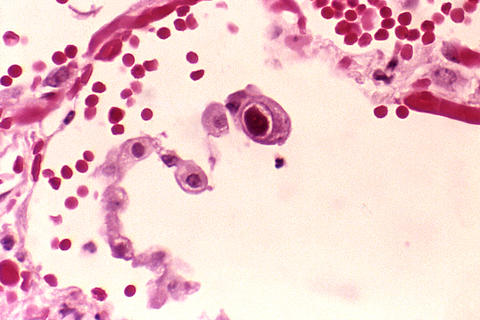
Photomicrograph showing human lung cells infected with cytomegalovirus. Cell at center clearly shows virus particles (large dark red mass) in its nucleus.
A new clinical Standard Reference Material (SRM) from the National Institute of Standards and Technology (NIST) will help health care professionals more accurately diagnose and treat cytomegalovirus (CMV), a common pathogen that is particularly dangerous for infants and persons with weakened immune systems.
CMV is found in 50 to 80 percent of the population. It is a member of the herpes family of viruses that includes two herpes simplex viruses (the causes of cold sores and genital herpes), the varicella-zoster virus (the cause of chicken pox and shingles) and the Epstein-Barr virus (the cause of mononucleosis). Like its cousin herpes viruses, CMV generally remains latent in an infected person unless certain conditions trigger its activation. CMV poses a significant health risk to people who are immunocompromised (such as organ transplant patients or cancer patients undergoing chemotherapy) and babies who receive the virus from their mothers before birth. Congenital CMV infections cause more long-term problems and childhood deaths than many other prenatal disorders including fetal alcohol syndrome, Down syndrome and neural tube defects such as spinal bifida.
If a CMV infection becomes dangerous, antiviral agents can be used to moderate the impact. Unfortunately, many of these compounds are toxic, so a physician must know the severity of the infection—a measure known as viral load (number of virus copies per microliter of blood)—to prescribe the optimal dosage and duration of treatment. The current means of measuring viral load is to use polymerase chain reaction (PCR)—the standard technique for "amplifying" or making multiple copies of a DNA segment or molecule—to amplify a region of the CMV gene and then use a calibration curve to estimate the number of virus particles in the original sample. Accuracy of these measurements can vary greatly from one test facility to another as there are many different PCR protocols used to determine viral load, including commercial and "in-house" (privately developed) laboratory assays.
The new NIST reference, SRM 2366, addresses the variability problem by providing a standardized CMV DNA. Consistency of the viral DNA in the standard was ensured by manufacturing it in Escherichia coli bacteria. These E. coli cells each contain a copy of the CMV genome in a "DNA construct"—an artificially constructed segment of nucleic acid that codes for a specific product, in this case, CMV DNA. The DNA copies made by this E. coli cell culture "factory" can then be purified and quantified using digital PCR
SRM 2366 consists of three solutions, each with a specific concentration of CMV DNA copies per microliter: 420, 1,702 and 19,641. These are designed to qualify prepared calibration samples (known as calibrants). They also can be used as quality control samples for diagnostic equipment. For added traceability, the SRM certificate of analysis includes the genetic sequences of the nine CMV genome regions copied for the standard.
SRM 2366 joins more than 50 reference materials produced by NIST for quality control in clinical testing. Standard Reference Materials are among the most widely distributed and used products from NIST. The agency prepares, analyzes and distributes about 1,300 different materials that are used throughout the world to check the accuracy of instruments, validate test procedures and serve as the basis for quality control standards worldwide.
To get information on purchasing SRM 2366 and download the certificate of analysis, go to https://www-s.nist.gov/srmors/view_detail.cfm?srm=2366.

